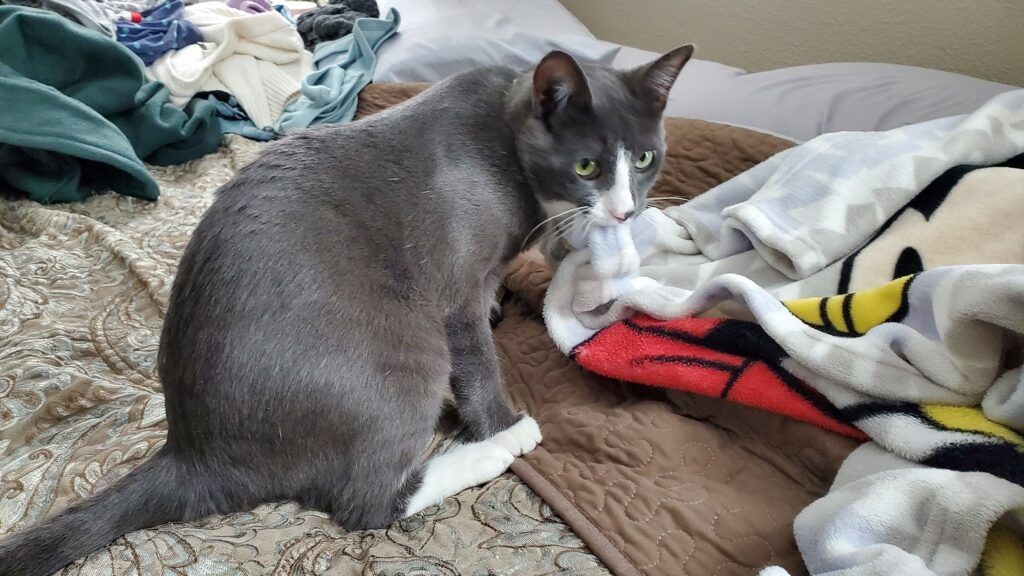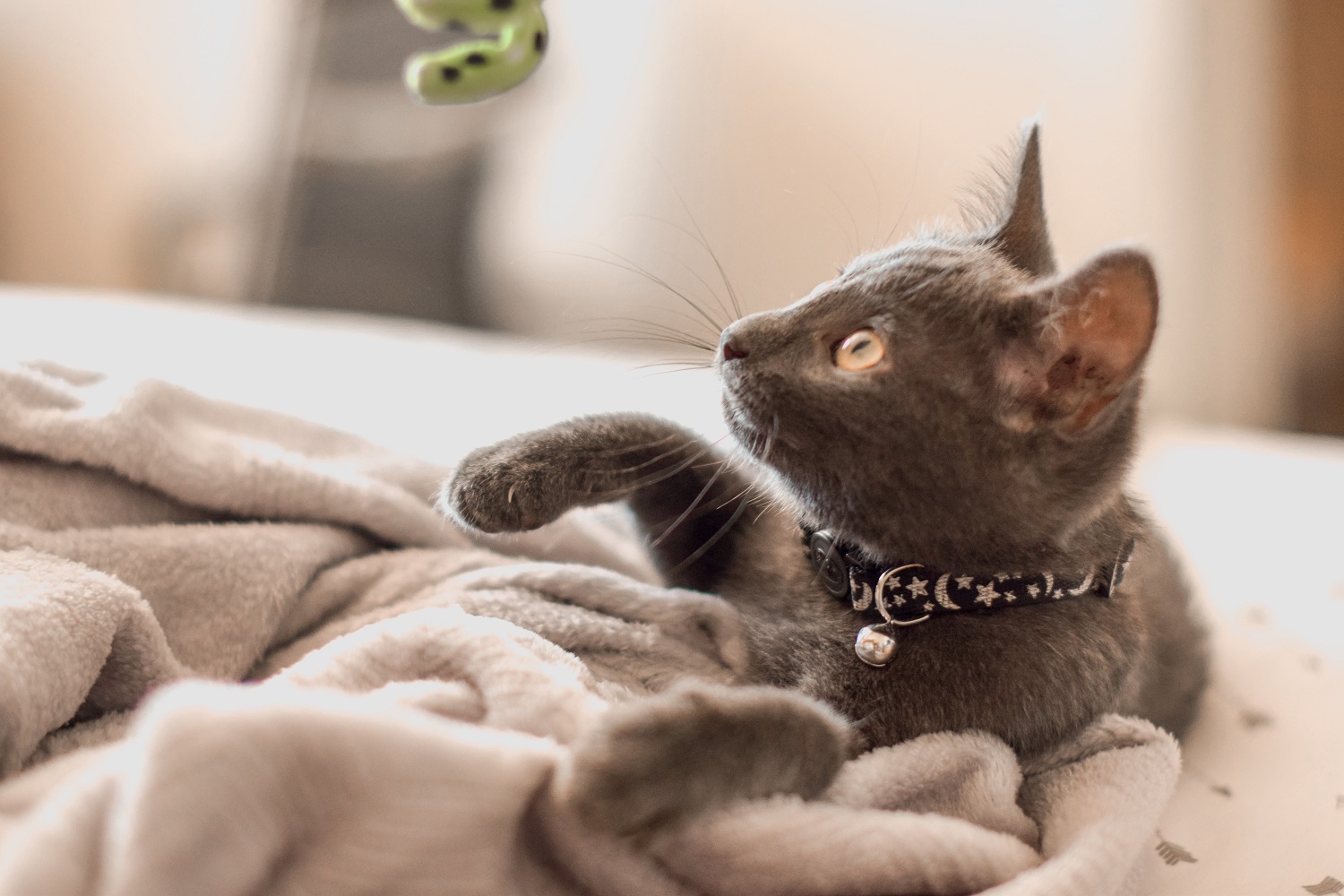If your kitten has suddenly decided your blanket is their personal chew toy and tug-of-war partner, you’re probably confused, slightly amused, and maybe even a little concerned. Is this normal? Is it weird? Are they trying to tell you something?
Good news: it’s normal. Great news: it’s also kind of adorable. Let’s break down what’s really going on when your kitten starts biting, dragging, and possibly bunny-kicking your favorite throw blanket.
Why do kittens bite and drag blankets? This quirky behavior can mean a few different things, depending on the context, your kitten’s age, and how intense the biting is. Here are the most common reasons:
Play Instinct and Hunting Practice
Blankets move. They ripple. They bunch up and fold in mysterious ways. To your kitten, that’s a sign of life. And life, in the wild, often means prey.
Kittens have strong hunting instincts, and blankets give them the perfect opportunity to:
- Stalk
- Pounce
- Bite
- “Kill” and drag their pretend prey
Dragging it around is just a proud victory lap. If your kitten finishes with a dramatic flop or a grooming session, congrats. That blanket hunt was a success.
Comfort-Seeking and Kitten-Like Behavior
Some kittens bite or suck on blankets because it reminds them of nursing. This is especially common in kittens who were weaned too early or didn’t get enough time with their mom.
If you notice your kitten:
- Kneading the blanket
- Suckling while purring
- Seeming especially calm or drowsy during the behavior
…then it’s more about comfort than play. This is a self-soothing habit and can last well into adulthood, especially in cats with strong emotional bonds to soft items.

I’ll show my humans who’s boss. They think they can keep me from biting their fancy things, but they can’t stop me from chewing Mom’s blanket! #KittenLife #FierceHunter #SoSoftAndChewy #CaughtInTheAct
Winston
Territorial Behavior
In some cases, your kitten might be treating the blanket as their own territory. Biting and dragging can be a way of marking it or moving it to a preferred location. Cats often like to arrange their environment to their liking, even if it doesn’t make sense to us.
Don’t be surprised if your kitten tries to stash your blanket in a favorite nap spot or wrestles it into a hiding place under the bed.
Overstimulation or Boredom
If your kitten is biting or attacking the blanket with wild energy, ears pinned, tail twitching, eyes wide, it could be a sign they need more playtime. They’re using the blanket to burn off steam.
This can happen when a kitten hasn’t had enough:
- Interactive play
- Mental stimulation
- Physical activity
Blankets become the stand-in for toys, prey, or anything else that helps them blow off kitten steam.
Should You Be Concerned?
Most of the time, this behavior is harmless. But if you notice any of the following, it’s worth paying attention:
- Chewing and swallowing fabric (this can be dangerous)
- Frantic, aggressive behavior that doesn’t respond to redirection
- Sudden increase in the behavior combined with anxiety or hiding
If your kitten starts actually ingesting pieces of the blanket, talk to your vet right away. That could be a condition called pica, which needs professional attention.
What You Can Do About It
If you don’t mind the behavior and your kitten isn’t eating fabric, there’s no real need to stop it. But if you’d prefer your blanket not be the main target, here are some tips:
1. Offer alternatives:
Provide toys that mimic prey behavior, like wand toys, kicker toys, or stuffed animals they can bite and carry.
2. Increase playtime:
A couple of dedicated 10-minute play sessions each day can help redirect your kitten’s energy.
3. Use a designated blanket:
Some people simply give their kitten a soft “comfort” blanket that’s allowed to be chewed and dragged. Problem solved.
4. Keep blankets out of reach:
If it’s one specific blanket they’re attached to, and you don’t want it ruined, keep it in a closed closet or storage bin when not in use.
Final Thoughts: Let Them Have Their Blanket Moments
Whether your kitten is hunting, snuggling, or just being a goofball, blanket biting and dragging is almost always a normal part of growing up feline. As long as they’re not ingesting fabric or acting distressed, it’s just one more quirky behavior to love.
You’ve got a happy, curious kitten exploring their world. One blanket at a time.
Sources:
– Why Cats Knead and Suck on Blankets https://www.petmd.com/cat/behavior/why-cats-knead-and-suck-blankets
– Understanding Kitten Play Behavior https://www.aspca.org/pet-care/cat-care/common-cat-behavior-issues
– Pica in Cats: When Chewing Becomes Dangerous https://vcahospitals.com/know-your-pet/pica-in-cats
– Feline Behavior Basics https://www.humanesociety.org/resources/understanding-your-cats-behavior
– How to Redirect Play Aggression in Kittens https://www.icatcare.org/advice/play-aggression-in-cats/
Recent Posts
Your Cat Might Be a Furry Little Healer… or at Least a Fuzzy Alarm System If you’ve ever had your cat suddenly become extra clingy when you’re under the weather, you’re not alone. From...
Cats are experts at hiding things, socks under furniture, their disdain for your playlist, and, unfortunately, symptoms of illness. In the wild, showing weakness could make them a target, so even...


